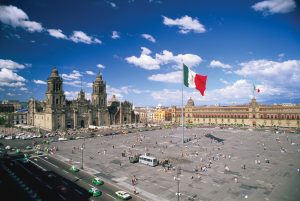We walked to the Edifico de Correos, the magisterial headquarters of the national postal service where we were scheduled to meet our guide. Like me, Mónica Unikel attended the Yidishe Shule, the Yiddish-language day school, then on Calle San Lorenzo. While there are plenty of tour guides around, Mónica, a sociologist and history buff, is the only one concentrating exclusively on Mexico’s Jewish past.
“Lacking a clear career path while I was raising my kids, I took a trip to England,” she said. “I felt the urge to visit London’s old Jewish neighborhood and was impressed by the coherence with which the guide described it.” Mónica decided to do the same for her beloved Centro Histórico while she figured out what to do with her life. “I thought that after repeating the tour so many times, I might get bored and train someone else to do it. But 13 years have gone by. I’m hooked.”
I told Mónica I hadn’t been in the Centro Histórico since my teens, when I used to accompany my father, a theater actor and telenovela star, on business. On our way back, he would take me to the Café La Blanca, where I would eat churros with hot chocolate. In 1940, when my father was just seven years old, his father took him to the nearby Palacio de Bellas Artes, where the body of León Trotsky, assassinated by NKVD envoy Ramón Mercader with an ice axe blow to the skull, rested in an open casket. There were long lines to see the man whom Trotsky’s biographer, Isaac Deutscher, called “the prophet outcast.” The image was stamped forever in my father’s memory. And he passed it on to me.

The Catedral Metropolitans is the largest cathedral in the Americas and was built between the 16th and 18th centuries atop a sacred Aztec site.
It towers over Mexico City’s grand Zocalo (square) and the Centro Historico. The streets where Jews lived and worked surround the Zocalo.
Even on a Sunday, the day we chose for no other reason than to be stuck as little as possible in urban congestion, the Centro Histórico was packed: Sidewalks were bustling with passersby and there were more automobiles than any road could handle. Mónica led us through the chaos to Calle Tacuba #15, the building in which Mexico’s first Jewish community cultural hall was established.
I had heard much about this building when I was growing up. (If at any point it had a name, people no longer remember it, using instead the address to refer to it.) While still single, some of the early East European Jewish immigrants lived nearby on Calle Moneda, behind the Catedral Metropolitana on the Zócalo. They and their friends congregated at Calle Tacuba #15, whose ample rooms housed a library and were home to Yiddish plays and klezmer concerts. I’ve come across pictures of political forums in these premises where anarchists, socialists, Zionists and Bundists passionately debated their ideas. There were Spanish-language classes. Plus, it was the place where aboneros, salesmen, gathered to establish a banking organization.
Now the building is empty and cold, as if frozen in another age, but the sight of it visibly moved my mother, who exclaimed that this was where her parents had been married. She reminded me of the sepia photograph of the ceremony that I had often seen. “¡Y los de tu papá también, Ilan!” my mother added, relating that my father’s parents’ wedding had also taken place in Tacuba #15. I longed to see each and every one of my grandparents at a younger age than when I knew them, to greet them, to thank them from the bottom of my heart for their courage, their determination to live, to escape pogroms, to make a new life in a strange country. I wanted to hear how they pronounced the word México with an inescapable Yiddish accent. I felt surprisingly homesick.
Mónica’s tour included a stop at Gante #5, one of the churches—Methodist Episcopal to be exact—that was used at some point by Ladino-speaking immigrants from Turkey, Greece and the Balkan region for services until that community built its own modern-looking synagogue in 1942 on Calle Monterrey, about 15 minutes away by car. I pondered Mexico’s Jewish ethnic diversity. Although until recently the descendants of Yiddish-speaking Ashkenazi Jews were the most prominent in business and cultural circles, they are only part of the Mexican Jewish story.

Having been born and raised in Mexico City, attended the same Jewish Day School, and with a very similar background, I was very touched by this excellent article of one of my favorite writers! I also felt a deep kinship with all that was described and will perhaps try to do “the tour” on one of my return trips. Thank you!